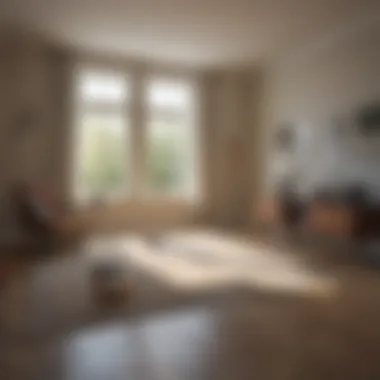Accurate Methods to Measure House Square Footage


Intro
Understanding the square footage of a house is not just a trivial pursuit for homeowners or real estate enthusiasts. It’s a cornerstone of property valuation, affecting everything from market prices to aesthetic decisions. When you're deep in the weeds of house hunting, the square footage plays a crucial role in determining whether a space meets your needs. Do you ever wonder how to accurately measure those cozy nooks or expansive living areas?
In this guide, we will delve into the art and science of calculating square footage, unraveling common methodologies and highlighting essential considerations. We will aim to equip readers not only with practical techniques but also with insights into how these numbers translate into usable space, comfort, and investment potential. This knowledge will shine especially bright for architects, design enthusiasts, and homeowners.
Home Design Inspiration
When contemplating square footage, one often overlooks how home design influences functionality and personal style. The interplay of architectural styles and innovative decor trends should serve as an equally important factor in decision-making.
Architectural Styles
There’s a rich tapestry of architectural styles that can guide one’s vision for a home. From the sleek lines of modernist designs to the classic charm of colonial homes, each style carries its unique appeal. For instance, a Victorian house, with its intricate moldings and varied rooflines, might feel larger than it actually is due to its strategic use of space and light.
Conversely, minimalist designs lean toward open floor plans, which can also enhance the perception of size in a home. Comprehending these styles helps potential homeowners visualize how square footage manifests in their lived experience. Here are a few styles worth exploring:
- Ranch: Defined by its long, low profile and open layout, perfect for efficient square footage use.
- Contemporary: Focuses on current trends, often featuring large windows which bring in natural light, making the space feel airy.
- Craftsman: Known for their handcrafted details and built-in furniture that maximize functional space.
Innovative Decor Trends
Creativity doesn’t end with architecture; it also flows into interior decor. The trends can help in maximizing small spaces or enhancing larger areas. Using multifunctional furniture can cleverly reduce clutter and visually expand a home. For example, consider a sofa that converts into a bed or a table that doubles as a workspace. These innovations can stretch your usable square footage significantly.
- Opting for light color palettes can create an illusion of a larger space.
- Mirrors can play tricks on the eye, reflecting light and making areas feel more open.
"Every inch counts when you're measuring square footage; however, it’s how you utilize that space that gives it meaning and warmth."
Finale
Calculating square footage is far more intricate than just straight measurements. It intertwines with design philosophy and trends that either complement or challenge the way we inhabit our spaces. In the journey of determining square footage, understanding how design impacts the perception and functionality of space ultimately enhances the overall experience in a home. With careful attention to detail and a bit of creativity, measuring one’s home can turn from a mundane task into a thoughtful exploration of architectural aesthetics and innovative living.
Understanding Square Footage
Understanding square footage is a fundamental aspect of home ownership, real estate transactions, and design. Regardless of whether one is buying, selling, or simply appraising a space, knowing the exact measurements of a residence allows for informed decision-making. The significance of square footage extends far beyond mere numbers; it influences perceptions of value, functionality, and livability.
Defining Square Footage
Square footage is a measurement of area, specifically the amount of space within the boundaries of a home or property. It is typically calculated by multiplying the length of a space by its width. In a simple case, if a room measures 10 feet by 12 feet, its square footage is 120 square feet. However, this seemingly straightforward formula can become tricky when dealing with irregular room shapes, alcoves, or extensions.
Additionally, different standards for calculating square footage may apply. For instance, some methodologies include finished basements, garages, and upper levels, while others may only account for livable space above grade. For the homeowner or buyer, understanding these nuances is important to avoid unpleasant surprises, particularly in real estate scenarios.
Why Square Footage Matters
Square footage carries considerable weight in many realms, particularly in real estate. Here’s why it’s essential:
- Market Value Assessment: A home's square footage often directly correlates with its market value. Larger homes typically command higher prices. Thus, understanding the square footage can help set realistic expectations for both buyers and sellers.
- Space Planning: Knowing the square footage helps in designing effective layouts. For instance, if you have a tiny living room, you want to avoid oversized furniture that overwhelms the space. Accurate measurements lead to more functional and aesthetically pleasing designs.
- Negotiation Power: In real estate dealings, having precise square footage can provide leverage. Discrepancies between the listed size and actual measurements can be grounds for negotiation.
For those involved in buying or selling a property, it’s always a good move to verify the square footage. Small differences can potentially lead to significant financial implications.
In summary, understanding square footage is essential not just for calculating space but also for comprehending its value in various contexts. Accurate measurements facilitate better decision-making, effective design, and can significantly affect one’s financial investments.
Preparation for Measuring
When it comes to figuring out the square footage of a house, the preparation stage is crucial. Think of it as laying the groundwork before you start building. A well-planned approach ensures accuracy and efficiency, making the process smoother. By prepping adequately, you not only avoid potential mistakes but also save time in the long run. Plus, having the right tools and a clear plan lays a solid foundation for successful measurements that you'll be confident in.


Gathering Necessary Tools
Before you get your hands dirty measuring walls and corners, you’ll want to gather a few essential tools. Here’s a checklist to consider:
- Measuring Tape: This is your best friend. A long, retractable measuring tape, preferably 25 feet or more, provides the flexibility to handle various room sizes.
- Laser Distance Measurer: If you have the budget, investing in a laser measurer helps you quickly and accurately capture dimensions without the fuss of a traditional tape.
- Notebook and Pencil: Keep things organized by jotting down dimensions. You’ll thank yourself later when compiling totals.
- Graph Paper: Useful for visualizing floor plans and keeping track of room layouts.
- Calculator or a Smartphone App: For quick calculations, a simple calculator or a specialized app can help you tally up area measurements efficiently.
Gathering these tools before starting will save you from running back and forth, which could throw you off your game.
Creating a Measurement Plan
Once you've got your tools in hand, it’s time to devise a clear measurement plan. A good plan is your roadmap to achieving accurate square footage.
- Room Prioritization: Identify which areas you need to measure. Start with larger spaces like living rooms and move to smaller ones such as closets. Don't forget about multi-level homes—each floor requires attention.
- Measuring Technique: Decide if you’ll measure one specific wall at a time or the entire room in one go. For big rooms, measuring one wall at a time may reduce errors.
- Document Everything: As you measure, write down each room’s length and width right away. Leaving notes for later can lead to inaccuracies. Mention specific features like alcoves or nooks that might affect total area calculations.
- Use a Consistent Scale: Ensure your measurements are taken in the same units. Whether you're in feet or meters, consistency is key for simplifying calculations later on.
- Double-Check: Before packing things away, re-measure critical areas. It’s better to take a little extra time than to find an error later when you’re calculating totals.
With these preparation steps in mind, you’re just a few measurements away from accurately determining your home’s square footage. This not only helps in real estate decisions but can also improve functionality in your living spaces.
Methods of Calculating Square Footage
Understanding how to calculate square footage accurately is a cornerstone of home evaluation and design. This section dives into the methodologies and intricacies involved in determining the square footage of a house. Not only does accurate measurement provide clarity for buyers and sellers alike, but it also greatly influences the functionality and aesthetics of a living space. Precision in this area can elevate a homeowner’s experience, enabling better design choices and promoting optimal space utilization.
Measuring Linear Dimensions
The foundation of square footage calculation lies in measuring linear dimensions. Essentially, this involves obtaining the length and width of a room or area and multiplying them together to find the total area. To start, one must use tools such as a measuring tape or laser measurer to get precise measurements.
Begin by measuring the room from wall to wall, ensuring that you are capturing the longest lengths of both dimensions. For instance, if you have a living room that is 15 feet wide and 20 feet long, your calculation would be:
[ Area = Length \times Width = 20 \text ft \times 15 \text ft = 300 \text sq ft ]
However, it’s important to consider any protrusions like closets or built-ins. For L-shaped or irregular spaces, it might be better to break them down into smaller rectangles, calculate each area, and then sum them up. This method not only brings accuracy but also helps in avoiding miscalculations stemming from overlooking any dimensions.
Calculating Total Area
Once you have your individual areas calculated, summing them gives you the total square footage of the house. This step is crucial especially in spaces that feature multiple rooms or distinct zones. A homeowner might have a two-bedroom house where one bedroom is 120 square feet and the other is 160 square feet; including the living areas, kitchen, and bathroom can lead toward a comprehensive total.
Consider this example:
- Living Room: 300 sq ft
- Kitchen: 200 sq ft
- Bedroom 1: 120 sq ft
- Bedroom 2: 160 sq ft
- Bathroom: 50 sq ft
Summing up these areas yields: [ Total Area = 300 + 200 + 120 + 160 + 50 = 830 \text sq ft ]
Realizing the significance of this calculation cannot be understated. For sellers, presenting accurate square footage can affect how the property is perceived in the market. For buyers, knowing the square footage is essential when comparing homes and checking value for their investment.
Considering Different Levels and Areas
Residential properties often consist of multiple levels and unique architectural features which complicate square footage measurements. In multi-story dwellings, measuring square footage extends beyond just a single floor. Each level must be accurately accounted for and summed to provide the total living area.
It’s essential to measure each floor individually. For example:
- First Floor: 800 sq ft
- Second Floor: 700 sq ft
Total Square Footage would then be: [ Total Area = 800 + 700 = 1500 \text sq ft ]
Furthermore, certain areas like attics, basements, and garages might not be included in the official square footage. Depending on local regulations or real estate norms, these spaces may or may not be factored into the total area calculation. Homeowners should check guidelines that apply to their region to ensure compliant and accurate reporting of their home’s square footage.


"Measuring square footage isn't just a formality; it's a significant factor that affects your property's assessment, tax implications, and even resale value."
Common Challenges in Measurement
Accurately determining the square footage of a house might sound straightforward, but the reality is often filled with hurdles. This section delves into the intricate challenges that can arise during measurement, offering insights into how to navigate them effectively. Addressing these challenges is pivotal, as they can drastically affect both the calculated area and the overall perception of a property’s space.
Dealing with Irregular Spaces
When measuring square footage, the presence of irregular spaces can throw a wrench in the works. These are areas that do not conform to standard geometric shapes, often found in older homes or unique architectural designs. Think of an L-shaped living room or a nook that juts out near a window. When faced with such spaces, it becomes necessary to break them down into manageable sections.
To measure these areas:
- Divide the irregular shape into smaller, recognizable shapes, such as rectangles or triangles.
- Measure the dimensions of each section carefully.
- Calculate the area of each individual shape and add them together to get the total square footage.
Consider visually approximating those sections before diving into the measurements. It's akin to slicing a pizza; you wouldn't munch on a single slice and expect to know how much overall pizza you have without considering the rest. Keeping a tape measure handy and maybe a sketch can really help visualize the arrangement.
Addressing Architectural Features
Architectural features, like bay windows or built-in shelves, add style and function to a home but can also complicate square footage calculations. These elements don’t always fit neatly into standard measurement methods. In these cases, it is crucial to discern between livable space and architectural adornments.
When measuring around these features:
- Make sure to focus on the livable areas, which is typically what's actively used rather than the spaces taken up by the feature itself.
- Identify the eaves and other protrusions that may not contribute to usable square footage, as not every unique architectural detail adds value space-wise.
- For particularly complex designs, consider consulting architectural drawings or blueprints to clarify how these features impact your overall measurements.
"Understanding how to handle the peculiarities of a home’s layout can influence not just the square footage but its marketability as well."
Whether it’s a quirky layout or architectural nuances, being armed with the right knowledge and tools makes the difference. By addressing these unique challenges in measuring space, homeowners, DIY enthusiasts, and real estate aficionados can enhance their understanding and appreciate the true breadth of a home’s dimensions.
Square Footage for Different House Types
Understanding the square footage of various house types is essential in the field of real estate. It not only affects market values but also impacts how people perceive space within those homes. Each style of dwelling comes with its unique nuances when it comes to calculating square footage and optimizing space. Here’s a closer look at each category, allowing prospective buyers, homeowners, and design lovers to grasp their distinct features.
Single-Family Homes
When it comes to single-family homes, square footage becomes a core measurement that drives value and desirability. These homes typically span larger plots of land, offering more flexibility in design and layout. Understanding the square footage helps buyers assess whether a property meets their needs for investment or living.
- Spatial Optimization: With single-family homes often encompassing living areas, bedrooms, basements, and sometimes attics or garages, knowing the exact floor area helps in planning efficient use of space.
- Value Assessment: Real estate agents often evaluate square footage to determine a home's market price. Generally, larger homes in good locations fetch a premium, but it’s imperative to consider the effective use of space over mere size.
- Outdoor Areas: Don’t forget to factor in any outdoor spaces such as porches or patios. These spaces, while not contributing directly to indoor square footage, can significantly enhance the property's livable feel.
Condos and Apartments
Condos and apartments present a different challenge when calculating square footage. While they may appear more straightforward due to their compact designs, several elements can complicate matters.
- Common Areas: Generally, the square footage listed for condos includes common areas, which can be a gray area for potential buyers. It's essential to clarify if the square footage reported relates to the unit alone or includes shared spaces.
- Balcony and Terrace Consideration: Many modern condominiums feature private balconies or terraces. While those extras might not be included in the official square footage, they provide valuable outdoor living space that shouldn't be overlooked.
- Layout Variability: Unlike single-family homes where layout can be diverse, condos are known for their shared walls and fixed designs. This makes it crucial for buyers to analyze practical layouts and check if the listed square footage encompasses all usable areas.
Multi-Story Dwellings
Multi-story dwellings, including townhouses and duplexes, add another layer of complexity regarding square footage calculations. Each level might have different functions and amenities, which affects overall livability.
- Levels Matter: With multi-story homes, potential buyers should calculate the total area by adding each floor’s square footage. What's appealing about multi-level homes is the division of space; separate living areas can provide privacy and flexibility.
- Staircases and Hallways: Keep in mind that spaces like staircases and hallways, while essential, do not usually contribute to the livable square footage. Understanding this helps in accurately assessing usable living space across floors.
- Roof and Attic Areas: Sometimes, the upper levels might have sloped ceilings or attic spaces that can be utilized. It’s vital to check if these areas are included in the stated square footage since they can dramatically enhance living experience.
Understanding square footage in relation to different types of homes shapes not just purchasing decisions but also influences design and functionality aspirations.
Real Estate Implications


Understanding the nuances of square footage goes beyond mere measurements. It permeates the heart of real estate dynamics. A well-calibrated assessment of square footage informs buyers, sellers, and investors alike, offering insights into the value and livability of a property. When engaging with a home, square footage serves as the baseline metric upon which decisions are built. The intricate relationship between these metrics and real estate principles can’t be overstated, as it influences everything from market trends to personal investments.
Influence on Market Value
The role of square footage in determining market value is significant. Properties with larger square footage often command a higher price. However, not all square footage is created equal; qualities such as the distribution of space, layout, and the overall functionality can sway buyers’ perceptions. For instance:
- Perceived Value: A layout that seems spacious can feel like a bargain, even if the square footage is modest.
- Comparative Analysis: Real estate listings often rely on square footage when drawing comparisons. Buyers scrutinize similar homes and their square footage to gauge expectations and price.
- Exit Strategy: For investors, understanding square footage isn’t just about current value. It also factors into resale possibilities. A house that has expansive but poorly configured space may become a liability rather than an asset.
Consider this: If you’re looking to appraise a home, knowing how square footage relates to local market prices can mean the difference between a lucrative flip and a financial loss. The average price per square foot in your area can help shape an informed acquisition strategy, aligning your investment with market realities.
Square Footage Disclosures
Another vital aspect is square footage disclosures. These come into play when properties are listed for sale and entail the obligation of sellers to provide accurate and truthful details about the home’s square footage. This practice is crucial for several reasons:
- Consumer Protection: Correct disclosures protect buyers from misrepresentation. No one wants to discover they’ve purchased less space than advertised.
- Legal Considerations: Should discrepancies arise about square footage after a sale, sellers might face legal consequences. It's vital to get accurate measurements and to disclose them.
- Market Transparency: Transparency regarding square footage fosters trust in the real estate market, enhancing buyer confidence.
A good practice for homeowners and agents is to have square footage verified by professionals or through radified calculators. This blend of preciseness and integrity creates a sound foundation in real estate transactions, ensuring that everyone walks away satisfied.
Enhancing Residential Design with Accurate Measurements
In the world of residential design, measurements can make or break a project. Accurate square footage calculations not only influence the aesthetics of a home but also determine its practicality, efficiency, and overall appeal. By emphasizing correct measurements, designers and homeowners can create spaces that feel open, inviting, and functional rather than cramped or unwieldy.
When the square footage is calculated properly, you can design with confidence. Homeowners can ensure that their living environments cater to their needs—whether it's a cozy reading nook or an expansive living area that's perfect for entertaining. This foresight in planning can derive satisfaction and comfort in the daily use of a home.
Accurate measurements are not just numbers; they pave the way for creativity in residential design, enabling insightful spatial organization.
Maximizing Space Efficiency
Maximizing space efficiency starts with understanding how every square foot can be utilized. The objective is to make the most of available areas, reducing wasted space while enhancing movement flow.
- Open Concept Living: By measuring correctly, designers can craft open layouts that promote interaction without barriers. This allows homeowners to feel connected to the entire space, making even compact homes feel larger.
- Furniture Placement: Knowing the exact dimensions lets you determine the best placement of furniture. This information prevents overcrowding and enables the existence of pathways for effortless navigation between rooms.
- Storage Solutions: Smaller homes can greatly benefit from strategic storage designs which use vertical spaces or hidden compartments. Accurate square footage calculations can dictate how and where to incorporate clever storage to keep the home organized.
Implementing strategies that leverage square footage can lead to several benefits:
- Improved functionality of spaces
- Enhanced flow between different areas
- Increased potential for creative design solutions
Creating Functional Layouts
Functional layouts are the backbone of purposeful residential design. A well-structured floor plan respects the dimensions of each room while offering practical solutions that fit the lifestyle of its inhabitants.
To create a functional layout, consider these aspects:
- Traffic Patterns: Accurate measurements can identify the natural flow of movement through spaces. Thoughtful layouts will account for areas where people gather and how they move between them.
- Functional Zones: Dedicating areas for specific activities (like cooking, working, or relaxing) maintains order and purpose in the home. For example, knowing the square footage of kitchen spaces allows for proper placement of appliances, counters, and storage for cooking efficiency.
- Accessibility: Especially for those with mobility issues, ensuring that layouts accommodate easy access to all parts of the home is critical. Accurate dimensioning will assist in planning wider doorways and hallways that allow for comfortable movement.
Finale
Determining the square footage of a house may seem like a straightforward task, but it carries significant weight in various aspects of real estate and design. This article has dissected the concept, helping you understand not only how to measure square footage accurately but also why it matters in the grand scheme of things. From residential listings to functional layouts, knowing the exact measurements of a property can enhance decisions made by homeowners, architects, and potential buyers.
Recap of Key Points
Throughout this guide, we’ve highlighted several essential factors related to square footage:
- Defining square footage: Understanding what square footage encompasses, including livable space versus total area.
- Importance in real estate: The direct influence of square footage on property pricing and market value.
- Measurement methods: Various techniques for gathering dimensions, such as linear measuring, and dealing with irregular shapes.
- Challenges faced: Addressing architectural features and those tricky spaces that might skew measurement accuracy.
- Design implications: Utilizing square footage knowledge to maximize space efficiency and create practical layouts.
These discussions underline the necessity of precise measurements. Accurate square footage can significantly influence a buyer's decision and underscore the value of a property.
Future Considerations in Measurement
As the housing market evolves, so too do the methodologies employed in measuring square footage. With advancements in technology, such as the increasing use of digital measuring tools and mobile applications, capturing measurements may become quicker and easier. Here are a few points to ponder:
- Technological advancements: Expect to see more devices that utilize lasers or photogrammetry to assess space accurately and efficiently.
- Standardization: There’s a growing need for industry standards that ensure measurements are consistent across the board, potentially making comparisons simpler.
- Environmental considerations: As sustainable building grows in popularity, future measuring techniques might need to account for different dimensions related to energy efficiency and environmental impact.







